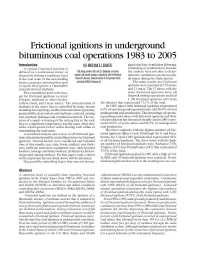Mining Publication: Frictional Ignitions in Underground Bituminous Coal Operations 1983-2005
Original creation date: August 2009
A statistical study of available data regarding frictional ignitions in the United States from 1983 to 2005 was conducted by the National Institute for Occupational Safety and Health (NIOSH) to determine and define conditions controlling their occurrence. Frictional ignitions are defined as the ignition of a flammable mixture of methane and air that is initiated by frictional heating. Ignitions created through the addition of energy from open flames and exposed electrical circuits are not included in this analysis. Energy released in a roof fall that creates a spark and ignites a methane mixture would be considered a frictional ignition. Frictional ignitions represent the majority of all ignitions in underground coal mines. Over the study period of 1983 to 2005, a total of 1,993 ignitions were reported in underground bituminous coal mines in the United States, of which 1,589 were frictional ignitions. Reportable ignitions to the U.S. Mine Safety and Health Administration (MSHA) are any unintentional occurrences of flame underground regardless of duration. Continuous miners represented the largest source for frictional ignitions with 1,090 (68.6% of all frictional ignitions). Longwall mining operations represented the highest concentration of frictional ignitions during this study period with 1,365 frictional ignitions (85.9% of all frictional ignitions). From 1983 to 1991, underground productivity and the number of frictional ignitions increased. However, productivity continued to increase from 1991 to 2000 while total frictional ignitions fell, thereby disproving this connection between productivity and frequency of frictional ignitions. Ninety percent of all frictional ignitions occurred in underground coal mines that liberated more than 393 L/s (1.2 MMcfd million cubic feet per day) of methane through the main ventilation system. Although methane production is not the determining factor for the occurrence of frictional ignitions, it is a good indicator of the anticipated frequency.
Authors: RB Krog, SJ Schatzel
Peer Reviewed Journal Article - August 2009
NIOSHTIC2 Number: 20036224
Source Min Eng 2009 Aug; 61(8):28-35
See Also
- Are lithium-ion cells intrinsically safe?
- Development and Application of Reservoir Models and Artificial Neural Networks for Optimizing Ventilation Air Requirements in Development Mining of Coal Seams
- Elastic and Shear Moduli of Coal Measure Rocks Derived from Basic Well Logs Using Fractal Statistics and Radial Basis Functions
- Methane Emission from U.S. Coal Mines in 1973, A Survey: A Supplement to IC 8558
- Methane Emission from U.S. Coal Mines in 1975, A Survey : A Supplement to Information Circulars 8558 and 8659
- Methane Emission from U.S. Coal Mines, A Survey
- NIOSH Research for Monitoring and Controlling Methane at U.S. Underground Coal Mining Operations
- Peak Methane Concentrations During Coal Mining: An Analysis
- Remote Methane Sensors
- Short-Delay Blasting in Underground Coal Mines
- Content source: National Institute for Occupational Safety and Health, Mining Program


 ShareCompartir
ShareCompartir
